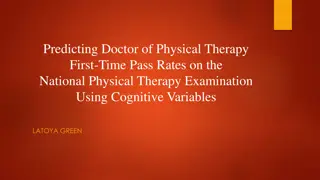The Impact of Boxing in Physical Therapy: A Non-Traditional Approach
Boxing is gaining popularity in physical therapy for addressing orthopedic and neurologic conditions. It offers benefits such as movement coordination, balance training, and confidence-building. Research indicates its effectiveness for conditions like cancer, stroke, multiple sclerosis, and Parkinson's disease. Additionally, boxing can enhance overall fitness and rehabilitation across various patient populations.
Download Presentation

Please find below an Image/Link to download the presentation.
The content on the website is provided AS IS for your information and personal use only. It may not be sold, licensed, or shared on other websites without obtaining consent from the author. Download presentation by click this link. If you encounter any issues during the download, it is possible that the publisher has removed the file from their server.
E N D
Presentation Transcript
Boxing: Making an Impact in Physical Therapy BY DANIEL VINCENT SPTA
A Non-Traditional Approach Boxing is seeing use in clinics worldwide to address a variety of orthopedic and neurologic conditions (Gonzalez, 2019). Included among other non-traditional treatments designed to apply standard exercises in an alternative manner. Ex. Tai Chi, Yoga, Qigong (Miller et. Al, 2010) In Healthy Adults (Miller et. Al, 2010) - Kravitz et al: UE boxing movements at all speeds provides enough intensity for cardiorespiratory fitness improvements - Bellinger et al: 60 minutes of boxing equals similar energy expenditure as running 5.6 miles in 60 minutes.
Why Boxing for PT? Movement coordination: UE extremity punching in concert with LE multidirectional footwork. Punching motions combined with trunk rotation, postural adjustments and multidirectional stepping (Miller et al, 2010) Distance judging, dynamic balance and endurance all together (Gonzalez, 2019). - Movement for orthopedic surgery recovery. - Vestibular input created by various movement patterns and visual cues to assist with post concussion rehab. - Uses rhythmic movements and patterns paired with balance challenges for neuro re-education - Build s a patient s confidence both in and out of the clinical setting. - Patient s look forward to their sessions because it is fun!
Why boxing for PT? Five common components of successful balance training programs for older adults (The five Vs) - Velocity: fast interactive body and head movements - Verticality: vertical bodily movements against gravity - Vigor: moderate-high intensity activity - Vision: visual system challenges - Vestibular: vestibular system challenges Kickboxing encompasses all components into a singular activity (Jackson et. Al, 2013)
What does the Research Say? Boxing is a full body fitness and rehabilitation strategy that, in addition to general fitness, can be applied to a variety of conditions seen and treated by Physical Therapists and Physical Therapy Assistants. Boxing has health applications for both neurologic and pathologic conditions, with significant research focusing on four common conditions addressed by physical therapy. Research studies on the following conditions 1. Cancer 2. Stroke 3. Multiple Sclerosis 4. Parkinson s Disease
Cancer Pilot study by Doherty et. Al on the benefits of boxing as an exercise method for those diagnosed with breast and ovarian cancer. Boxing was chosen as an adjunct to counter potential adverse effects produced by treatment such as surgery, radiation, chemotherapy, hormone and biological agents. Nine woman, ages 39-69 (3 ovarian cancer, 6 breast cancer) completed 11-47 fitness boxing classes on a heavy bag of eight three- minute rounds over the course of 8 weeks, following completion of traditional treatment. Outcome Measures chosen consisted of seven values often affected by breast and ovarian cancer treatment - 6-Minute Walk Test (6MWT), 30-second chair stand, MMT mid. and low trapezius, 4-stage balance test, B-tracks balance, hand grip dynamometry, and Functional Assessment Chronic Illness Therapy- Fatigue specific (FACIT-F) quality of life survey.
Cancer (Doherty et. Al, 2020) Outcomes of the Study - 6MWT distance increased between 3-1000 feet for 77% of participants. - 55% of participants improved by 1-3 reps in 30-second chair stand. - 66% showed improvement in bilateral mid trap and left lower trap MMT, and 77% improved in right lower trap strength. - Right hand grip strength improved in 55% while left hand improved in 66%, ranging from 1-7.33 kg increases - No change in 4-stage balance and B-tracks balance tests. - FACIT-F Survey results demonstrated general improvement in physical well being, and consistent, steady findings for social, emotional and functional well-being. - 88% of participants reported reduced levels of fatigue following thes study s conclusion.
Cancer (Doherty et. Al, 2020) Conclusions of the study. Participants reported general reductions in edema, lower stress levels and better sleep quality. This boxing program produced increased walking distance, scapular strength, grip strength and overall quality of life. Lack of balance improvement is thought to be due to participants beginning with a high level of balance. Boxing is shown to be an effective method of exercise for cancer patients dealing with adverse effects of treatment, and has potential for long term implementation for communities of cancer survivors.
Boxing has been shown to be an effective treatment option for the improvement of motor skills and cardiovascular fitness of stroke patients. Stroke Study by Park et. Al, 2017 - 26 participants total. 13 performing a sitting boxing program and 13 performing conventional PT, each 3x/week for 6 weeks - Manual Functional Test, hand grip of non-affected side, Berg Balance Scale (BBS), 10 minute walk test and Stroke-Specific Quality of Life questionnaire all demonstrated significantly greater improvements post treatment than the conventional PT control group. - Results indicate that boxing, including stretching, strength training and endurance raining all produced greater balance, gait, UE function and general quality of life for stroke patients.
Stroke (Hurkmans et. Al, 2011) secondary to reduced functional mobility. Inactivity can increase the risk of recurrent stroke and compounding cardiac events in survivors. ACSM/AHA exercise guidelines for healthy adults: 30 minutes of moderate intensity/3-6 METS 5 days a week. 20 minutes of intense/over 6 METS three days a week. ACSM/AHA recommends use of modified Borg scale (1-10) for intensity measures in older adults and those with chronic conditions. Modified Borg Scale: Moderate activity = 5-6, vigorous activity = 7-8. Deconditioning is a common complication
Stroke (Hurkmans et. Al, 2011) Use of boxing on Wii sports for cardiorespiratory fitness in stroke survivors was investigated in a 2011 study (Hurkmans et. Al). 10 chronic stroke survivors played 15 minute bouts of wii sports with energy expenditure measured during game play, and modified Borg levels reported after. All participants recorded MET levels between 3.4-5.7, and the average Modified Borg perceived exertion levels was 5.3. No adverse effects recorded, however supervision was found to be needed when participants with balance deficits played wii boxing. Conclusions - Wii boxing can be performed at sufficient intensity to provide cardiovascular benefit to stroke patients. - This study indicates boxing on an exergame console is a viable fitness and PT option.
Multiple Sclerosis Balance abnormalities are reported to be the most common and often first recognized symptoms of MS, even in the minimally impaired. 93.7% of middle aged/older adults with MS report balance and mobility problems. 50% report injuries from falls (Jackson and Edginton-Bigelow, 2013) Evidence suggests lower extremity power (force/time) bears strong relation to postural control in MS, suggesting kickboxing for quick force development (Jackson and Edginton- Bigelow, 2013).
Multiple Sclerosis (Jackson and Edginton-Bigelow, 2013) A 2013 study by Jackson and Edginton-Bigelow investigated the impact of kickboxing on MS patients mobility, balance, and overall quality of life. 15 participants with relapsing-remitting or secondary progressive MS in an outpatient rehab center. Exercise began as simple shadow boxing punch combos and progressed to include gloves, heavy bags and punch mitts. Kicks and knee movements were added by week 3, and progressed to bags and targets. Workouts were held 3 days/week for 5 weeks.
Multiple Sclerosis (Jackson and Edginton-Bigelow, 2013) Tests and measures - Baseline measurements taken 5 weeks prior. Pre- intervention measures taken immediately before beginning. Post intervention measures within one week of ending. - Outcome measures included gait speed, Timed Up and Go (TUG), BBS, Dynamic Gait Index (DGI), Mini- BESTest, Activities Specific Balance Confidence Scale (ABC) and Multiple Sclerosis Quality of Life 54 (MSQOL-54). - Mini-BESTest measures dynamic balance, anticipatory control, reactive control, sensory orientation and dynamic gait with 14 tasks that include compensatory stepping and dual tasking with ambulation.
Multiple Sclerosis (Jackson and Edginton-Bigelow, 2013) Results - Significant improvements recorded in most measures post-treatment. - Post intervention improvements: MiniBESTest 35%, gait speed 10%, TUG 11%, DGI 13%, ABC 19%. - BBS did not show improvement due to possible ceiling effect from higher level participants. - MSQOL-54 showed upward, non-statistically significant trend. - No adverse effects, safety issues or pseudo- symptom exacerbations were recorded during the study.
Parkinsons Disease Hallmark symptoms of PD (rigidity, tremors, bradykinesia, and postural instability) often have negative effects on mobility, balance and general quality of life. Treatments that include stretching, resistance training and aerobic endurance have shown to reduce the severity of PD symptoms. Traditional and non-traditional exercise treatment programs have been found to increase balance, endurance, general mobility, and overall mental outlook in PD patients. Boxing has been suggested as a non-traditional means to address both the physical and psychological deficits of Parkinson s Disease. (Combs et al. 2011)
Rocksteady Boxing Study (Combs et. Al, 2011) Aims of this case series were to investigate the short-term and long-term effects of boxing training at various durations on the motor abilities and overall QoL of patients with mild through severe PD. Seven participants over the age of 21, able to ambulate independently with or without a device, not currently participating in PT and new to boxing, enrolled in Rocksteady Boxing (RSB) and were followed for 12 weeks. 3 participants with mild PD, and 3 with moderate to severe PD. Baseline testing took place 1 week prior to intervention, and progress testing took place at the end of 12 weeks Participants were tested again at 24 and 36 weeks, whether or not they continued with RSB.
Rocksteady Boxing Study (Combs et. Al, 2011) Tests and measures focused on four domains. Balance: Functional Reach Test (FRT) to measure stability, BBS for functional standing balance, and ABC to measure confidence in various functional balance activities. Gait and Mobility: TUG for general mobility and 6MWT for endurance. Spatiotemporal gait parameters including speed, cadence, stride length and step width, were measured with the GaitRite Walkway System,
Rocksteady Boxing Study (Combs et. Al, 2011) Fourth Domains PD-Specific Disability and Quality of Life -Unified Parkinson Disease Rating Scale (UPDRS): Activities of daily living and motor examination were measured in two subscales, with a lower UPDRS score indicating higher function. -Parkinson Disease Quality of Life Scale (PDQL): Self- reported survey of 37 questions, with a higher score indicating higher Feasibility and Safety: Evaluated by attendance rate over 12 weeks, with the goal of 24 sessions minimum, and by incidence rate of adverse events. perceived QoL.
Rocksteady Boxing Study (Combs et. Al, 2011) Intervention Procedures. 24-36 sessions 90 minutes long over a 12-week course. Optional to continue beyond 12 weeks. 20-minute warm-up focused on trunk and extremity muscles. 45-60 minute circuit training of 3-minute rounds with 1- minute rest breaks. Circuits included punching on heavy bags, focus mitts, overhead speed bags and cylindrical bags. Full body strength, endurance and footwork activities were included as well. Activities varied, but training format remained consistent.
Rocksteady Boxing Study (Combs et. Al, 2011) Outcomes and Results Balance: All participants improved in every balance measure over 12-24 weeks, and most continued to improve up to 36 weeks. For all balance measures, consistent improvements were seen in mod/severe PD cases, and small improvements in mild cases. Gait and Mobility: All patients demonstrated improvements between 10%-23% in all measures. Mild PD patients achieved these results by 12 weeks, and mod/severe PD patients achieved similar results by the final test at 36 weeks.
Rocksteady Boxing Study (Combs et. Al, 2011) Outcomes and Results PD-Specific Disability and Quality of Life -All participants showed consistent decreases in the ADL subsection of the UPDRS, while scores fluctuated on the motor component with mod/severe patients showing the most motor improvement. - Both mild and mod/severe PD patients showed consistent PDQL improvements, with mod/severe cases demonstrating the greatest improved perceived quality of life. Feasibility and Safety: No adverse incidents were reported, and all but one patient chose to continue with RSB following the initial 12 weeks.
Rocksteady Boxing Study (Combs et. Al, 2011) Conclusions Wide ranging improvements in all measures are thought to be credited to the full body approach of the program, including stepping, reaching, dynamic balance and agility. Earlier improvements in mild PD cases are suspect to be due to a higher training capacity in less severe disease cases. The choice to continue beyond the initial 12 weeks indicates patient enjoyment of the program, and progress continued to be made despite less frequent sessions after 12 weeks. Boxing is a feasible community intervention for PD patients regardless of disease severity.
The Case for Boxing Boxing challenges the body in all planes of motion, improves dynamic strength, balance, coordination and endurance, and can address the needs of many neurologic, pathologic and orthopedic conditions. It is a fun, active and enjoyable task that many patients will look forward to. Confidence and an improved outlook is forged, along with functional improvements. Many options for implementation are available, including focus mitts, heavy bag training, shadow boxing and exergame/VR applications. Community classes can create a sense of togetherness and belonging.
Citations Combs, S. A., Diehl, M. D., Staples, W. H., Conn, L., Davis, K., Lewis, N., & Schaneman, K. (2011). Boxing training for patients with parkinson disease: A case series. Physical Therapy,91(1), 132-142. doi:10.2522/ptj.20100142 Doherty, D., Felisky, P., Morton, K., & Sumner, K. (2020). Functional benefits of fitness boxing for survivors diagnosed with breast or ovarian cancer: A pilot study..reo.0000000000000229 Gonzalez, F. (2019, April 09). Get your move back with boxing. Retrieved April 14, 2021, from https://foothillsrehab.com/blog-physical-therapy-boxing- advantages/ Hurkmans, H. L., Ribbers, G. M., Streur-Kranenburg, M. F., Stam, H. J., & Van den Berg- Emons, R. J. (2011). Energy expenditure in Chronic stroke patients playing Wii Sports: A pilot study. Journal of NeuroEngineering doi:10.1186/1743-0003-8-38 and Rehabilitation,8(1), 38.
Citations Jackson, K., PT, PhD, GCS, & Edington-Bigelow, K., PhD. (2013, April 19). Kickboxing: A creative approach to improving balance in patients with Multiple sclerosis: Lower Extremity Review magazine. Retrieved April 14, 2021, from https://lermagazine.com/cover_story/kickboxing-a- creative-approach-to-improving-balance-in-patients-with- multiple- sclerosis Miller, S. A., Staples, W., Conn, L., Diehl, M. D., Davis, K., Lewis, N., & Schaneman, K. (2010, November 18). Boxing training for patients with parkinson disease: A case series. Retrieved April 14, 2021, from https://pubmed.ncbi.nlm.nih.gov/21088118/ Park, J., Gong, J., & Yim, J. (2017). Effects of a sitting boxing program on upper limb function, balance, gait, and quality of life in stroke patients. NeuroRehabilitation,40(1), 77-86. doi:10.3233/nre- 161392























